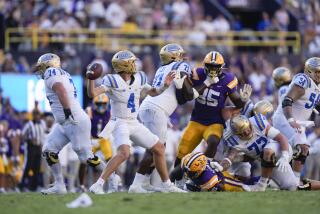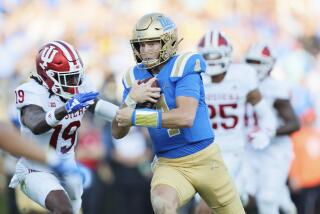Clearing All Hurdles : Titan Coach Kamaka Refuses to Let Tragic Accident Keep Him Down
FULLERTON â The day remains so vivid, locked away in his mindâs eye. Ron Kamaka had worked out, done a few things in the elementary school classroom where he was teaching in Hawaii, had lunch with his sister, and then went with a girlfriend to a beach to enjoy one of the last few days of summer vacation.
The sun was warm and bright, the water a dazzling blue. A wonderful day to be young, healthy and so full of fun.
An outstanding athlete at Rohnert Park High in the Bay Area and a former captain of the Arizona State track team, Kamaka decided heâd do some bodysurfing.
After only a few minutes in the water, he found a wave but took it late. Then, when he tried to roll out of it, the surf grabbed him and tossed him into a sandbar.
It was a day that changed his life, and nearly ended it.
Seven years later, it is another warm, sunny day, and Kamaka is doing something he has always wanted to do: He is coaching track. He is an assistant at Cal State Fullerton.
âI feel blessed,â he said. âI love what I do. I love the challenges of working with kids and doing the best I can to help them.â
But the bar has been raised for him.
Kamaka, who soared above 7 feet numerous times as a college high jumper, is paralyzed.
He has no feeling in his body from the lower part of his chest down. He is able to move his arms, and he can use his hands to some extent, but gripping is a problem.
It has been a long, and sometimes agonizing battle for him to get to this point. The accident shattered his fifth, sixth and seventh vertebrae, dislodged a disk and severed his spinal cord. He spent 5 1/2 months in the hospital for surgery, recovery and rehabilitation, and when it was over, he knew he might be in a wheelchair the rest of his life.
But he had come within a gasp of death, and somehow survived.
âWhen I went under the water, I couldnât move,â he said. âI tried to hold my breath, but it was really difficult. I remember blowing out my last breath of air, and taking in a mouthful of water. I had accepted the fact that I was going to die. But just at that moment, somebody from the beach pulled me up. I never lost consciousness, and I could tell my body felt different.â
After lying in the hospital bed for several months, Kamaka knew he was at an emotional crossroads.
âI was at the point where you either continue to dwell on your situation or you move on,â Kamaka said. âI decided to move on. I got on a plane and came back to live with my mother in Irvine. She and my brother were my care-givers that first year.â
In therapy, he saw others in more difficult circumstances and he was challenged by it.
Kamaka says he decided he âwanted to do something productive,â and volunteered to help at Los Naranjos Elementary school in Irvine. The principal, Bruce Baron, welcomed the idea.
âThe kids were terrific, and it was great for me,â Kamaka said.
He also became a volunteer coach at Woodbridge High.
Then, in 1995, Kamaka learned that Cal State Fullerton Coach John Elders was looking for some help with his track team. Again, Kamaka volunteered.
âI went over there to apply, and John asked me to work for a little while with one of their high jumpers, Zaylore Stout. He watched and listened, and about five minutes later, he walked over and said, âThe job is yours.â â
Elders remembers.
âI guess I was a little apprehensive at first,â Elders said. âI mean, hereâs a guy in a wheelchair. I had never had that much experience with anyone like that. I guess it was the fear factor. I probably was a little taken back at first.â
Watching Kamaka working with Stout quickly ended any of his concerns.
âI could recognize right away that he knew his stuff and could work with an athlete,â Elders said. âWhen I look at him now, I donât even think about him being in a wheelchair. Itâs sad that other people might think the way I did at first. Anyone who thinks of him as being different is really missing out.â
Kamaka, 34, says dealing with the changes in his life was difficult for himself as well.
âIâd always identified myself as an athlete,â he said. âI know now Iâd always had a fairly shallow perspective. I had to totally relearn who I was. And that was a painful process. When I was an athlete, Iâd show up on a basketball court and always be one of the first players picked to play. But sometimes as a disabled person, youâre picked only if the space permits it. That took a lot of patience for me. It was very difficult for me to ask anyone to do something for me.â
For a while, when he started coaching at Fullerton, Kamaka took city buses to the campus. It was a three-hour trip each way. âAnd there were a few times I missed the last bus in Santa Ana, and had to wait there until around 9 oâclock when I could get a ride from there with a friend,â he said, remembering it with a smile.
Only in the last couple of years has Kamaka had a van with special equipment that enables him to drive himself. âThat makes a big difference for me,â he said.
The schedule of a coach works well for him.
âIt would be hard for me to have a job where Iâd have to be at work at say 7:30 in the morning, since it takes me quite a bit of time in the morning just to get ready, and I need an attendant to help me,â Kamaka said. âBut this job allows some sort of normalcy in my life.â
Kamaka helps Elders scout and recruit athletes. âI make telephone calls, write letters to recruits and read the newspapers to see how the various athletes are doing,â he said.
Both he and Elders are devout Christians and are reviving the Fellowship of Christian Athletes chapter on the campus.
Kamaka says his life also has become enriched since he was married in January.
âMy wife Lynda is a wonderful lady,â he said. âShe loves the Lord the way I do. I take my strength from Him. He teaches me to be happy with the gifts that are provided to me, and thatâs what I do.
âBefore the accident I thought a lot about being married and being a father, then I didnât think about it. At one time, I coached her daughter at Woodbridge, so we met that way. Being married has been a real joy in my life.â
Elders says Kamaka has become one of his best friends.
âI really believe that God put us together,â Elders said. âOne of the greatest things was when Ron asked me to be in the wedding. Heâs inspired me with his faith and his enthusiasm for the sport. Even the little daily things he has to overcome makes you appreciate him that much more. Heâs a great example for our athletes.â
They share that appreciation.
âHeâs a good friend to me as well as a great coach,â high jumper Jason Pfaff said. âHeâs been there and done things that Iâm still trying to do. Heâs helped me a lot just by talking to me.â
Gaylore Stout agrees. âIâve learned more from him than any coach Iâve ever had,â Stout said. âEven though he canât physically show me what to do, and canât replicate it, he explains it so well that itâs like he is doing it.â
Kamaka coaches the high jumpers, long jumpers and hurdlers. He says he feels a strong bond with them, especially the high jumpers.
âHigh jumping is one of those events that always ends in a failure,â he said. âItâs important for me to be able to move them out of that mind-set. Thereâs always a positive side, even to a bad performance.â
Kamaka says he talks to them about much more than the techniques of high jumping.
âWe talk about a lot of things, and I make no bones about what I think is right or wrong,â he said. âI spend time trying to get into their heads. I want to see the things that I canât see on a videotape of them jumping.â
And he listens when they tell him about their problems, on the track and off.
âI know what itâs like when they tell me something hurts,â he said. â I was stuck in a hospital bed for more than five months. I know what itâs like to feel like you really need a boost.â
Kamaka has a videotape of his own, showing him high jumping in college. Occasionally, he will show it to his athletes. But Kamaka, whose jump of 7-3 1/2 in 1984 still ranks as the third best at Arizona State, says he never envisions himself flying high above the bar again when he watches them. âNo,â he said. âBut I look at it with great admiration. I just want them to be able to do something they feel is really, really special.â
More to Read
Go beyond the scoreboard
Get the latest on L.A.'s teams in the daily Sports Report newsletter.
You may occasionally receive promotional content from the Los Angeles Times.










